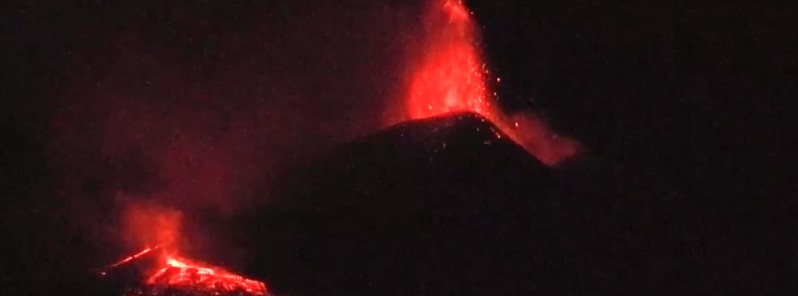17th paroxysmal eruptive episode at Etna forces closure of Catania International Airport, Italy

The 17th paroxysmal eruptive episode since February 16 started at Etna volcano, Italy at 23:00 UTC on Wednesday, March 31, 2021. The Aviation Color Code was raised to Red at 19:11 UTC on March 31 and remains at this level as of 09:32 UTC when the last VONA was issued. 7 people who got lost on the mountain on Wednesday were rescued on Thursday morning.
The National Institute of Geophysics and Volcanology, Etnaeus Observatory (INGV-OE), informs that starting around 23:00 UTC on March 31, Strombolian activity at the Southeast Crater has gradually switched to a lava fountain, marking the start of the 17th paroxysm since February 16.
At 00:18 UTC on Thursday, April 1, a lava overflow started at the eastern edge of the Southeast Crater expanding in the upper part of the Valle del Bove.
The ash cloud rose up to 9 km (29 500 feet) a.s.l. by 07:47 UTC, drifting SSW.
The temporal trend of volcanic tremor amplitude highlights a continuous increase in values that have reached very high levels, INGV-OE reported at 01:52 UTC.
The center of the sources of volcanic tremor is located at the SE crater at an elevation between 2 500 m and 2 800 m (8 200 – 9 180 feet) above sea level.
This is the longest paroxysm in the sequence that started on February 16, 2021.
#Etna is erupting again on the evening of 31 March 2021, with strong explosive activity at the Southeast Crater, and emission of lava and "spattering" (ejection of blobs of liquid lava) from a vent at the south base of the Southeast Crater. View from home in Tremestieri Etneo pic.twitter.com/4RkTeMq42E
— Boris Behncke (@etnaboris) March 31, 2021
#volcan #volcano #Etna La 17ème phase paroxysmale continue de monter en puissance. Trois coulées et une belle activité explosive ce matin/The 17th paroxysmal sequence still slowly rises : 3 lava flows and a strong explosive activity this morning pic.twitter.com/FLLPlSfJsX
— CultureVolcan (@CultureVolcan) April 1, 2021
#Etna, nuova #eruzione nella notte, ancora attiva adesso pic.twitter.com/5ahsqTFq1J
— Turi Caggegi (@TuriCaggegi) April 1, 2021
Audio on. 17th paroxysm of Etna . Listen to the roars and chirping. #etna #vulcano #sicily #regionesiciliana #1aprile #mungibello @Regione_Sicilia @ParcoEtna pic.twitter.com/DGtX3hOHes
— Samuele Distefano (@samuelerunner) April 1, 2021
#Etna L'eruzione prosegue da 10 ore pic.twitter.com/rFIGCC2YRJ
— Local Team (@localteamtv) April 1, 2021
Some big stones have arrived on the vineyard in Contrada Nave. Thanks God they are very light and the vines are not in the vegetative phase. No damages.
.
.
.#etna #mountetna #etnawines #etnarosso #wine #winelover #sicily #organicwine #volcanicterroir #singlevineyard … pic.twitter.com/mUAY9ftXt4— SantaMariaLaNave (@LaNaveEtnaWines) April 1, 2021
" Classica vernice
Bianco #parossismo dell' #Etna!" #Catania #Sicily #Sicilia #Unesco #Italy #Italia #1aprile pic.twitter.com/IX4CUNc6eM— ciccioetna (@ciccioetna) April 1, 2021
The ash was scattered onto the nearby city of Catania and closed its international airport, ANSA reports.
Lapilli also fell onto a number of smaller towns and villages on Etna's southern slopes including Nicolosi, Trecastagni, Pedara, Aci Sant'Antonio and San Gregorio, where the eruptions rattled windows and doors.
According to ANSA, a group of seven young people ascended the volcano to see the latest eruption, got lost during high volcanic activity, and had to spend the night in the open. They were rescued on Thursday morning.
Geological summary
Mount Etna, towering above Catania, Sicily's second-largest city, has one of the world's longest documented records of historical volcanism, dating back to 1500 BCE.
Historical lava flows of basaltic composition cover much of the surface of this massive volcano, whose edifice is the highest and most voluminous in Italy.
The Mongibello stratovolcano, truncated by several small calderas, was constructed during the late Pleistocene and Holocene over an older shield volcano. The most prominent morphological feature of Etna is the Valle del Bove, a 5 x 10 km (5.1 x 6.2 miles) horseshoe-shaped caldera open to the east.
Two styles of eruptive activity typically occur at Etna. Persistent explosive eruptions, sometimes with minor lava emissions, take place from one or more of the three prominent summit craters, the Central Crater, NE Crater, and SE Crater (the latter formed in 1978).
Flank vents, typically with higher effusion rates, are less frequently active and originate from fissures that open progressively downward from near the summit (usually accompanied by strombolian eruptions at the upper end).
Cinder cones are commonly constructed over the vents of lower-flank lava flows. Lava flows extend to the foot of the volcano on all sides and have reached the sea over a broad area on the SE flank. (GVP)
Featured image: Eruption at Etna on March 31, 2021. Credit: Boris Behncke/INGV

Commenting rules and guidelines
We value the thoughts and opinions of our readers and welcome healthy discussions on our website. In order to maintain a respectful and positive community, we ask that all commenters follow these rules.